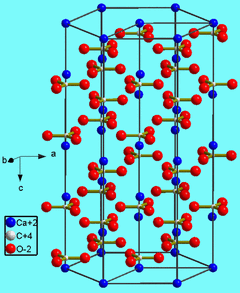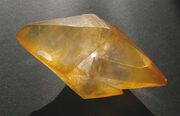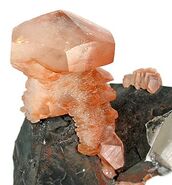| No Title | |
|---|---|
[[ |250px]] |250px]]A one-inch Calcite Rhomb that shows the Double image refraction property. | |
|
No Title |
No information |

Crystal structure of calcite
Calcite is a carbonate mineral and the most stable polymorph of calcium carbonate (CaCO3). The other polymorphs are the minerals aragonite and vaterite. Aragonite will change to calcite at 380-470 °C[1], and vaterite is even less stable.[citation needed]
Properties[]

Doubly terminated calcite crystal
Calcite crystals are trigonal-rhombohedral, though actual calcite rhombohedra are rare as natural crystals. However, they show a remarkable variety of habits including acute to obtuse rhombohedra, tabular forms, prisms, or various scalenohedra. Calcite exhibits several twinning types adding to the variety of observed forms. It may occur as fibrous, granular, lamellar, or compact. Cleavage is usually in three directions parallel to the rhombohedron form. Its fracture is conchoidal, but difficult to obtain.
It has a defining Mohs hardness of 3, a specific gravity of 2.71, and its luster is vitreous in crystallized varieties. Color is white or none, though shades of gray, red, orange, yellow, green, blue, violet, brown, or even black can occur when the mineral is charged with impurities.
Calcite is transparent to opaque and may occasionally show phosphorescence or fluorescence. A transparent variety called Iceland spar is used for optical purposes. Acute scalenohedral crystals are sometimes referred to as "dogtooth spar" while the rhombohedral form is sometimes referred to as "nailhead spar".
Single calcite crystals display an optical property called birefringence (double refraction). This strong birefringence causes objects viewed through a clear piece of calcite to appear doubled. The birefringent effect (using calcite) was first described by the Danish scientist Rasmus Bartholin in 1669. At a wavelength of ~590 nm calcite has ordinary and extraordinary refractive indices of 1.658 and 1.486, respectively.[2] Between 190 and 1700 nm, the ordinary refractive index varies roughly between 1.6 and 1.4, while the extraordinary refractive index varies between 1.9 and 1.5.[3]
Calcite, like most carbonates, will dissolve with most forms of acid. Calcite can be either dissolved by groundwater or precipitated by groundwater, depending on several factors including the water temperature, pH, and dissolved ion concentrations. Although calcite is fairly insoluble in cold water, acidity can cause dissolution of calcite and release of carbon dioxide gas. Calcite exhibits an unusual characteristic called retrograde solubility in which it becomes less soluble in water as the temperature increases. When conditions are right for precipitation, calcite forms mineral coatings that cement the existing rock grains together or it can fill fractures. When conditions are right for dissolution, the removal of calcite can dramatically increase the porosity and permeability of the rock, and if it continues for a long period of time may result in the formation of caverns, most notably the Snowy River Cave in Lincoln County, New Mexico.
Natural occurrence[]
The largest documented single crystals of calcite originated from Iceland, measured 7×7×2 m and 6×6×3 m and weighed about 250 tons.[4][5]
Calcite is a common constituent of sedimentary rocks, limestone in particular, much of which is formed from the shells of dead marine organisms. Approximately 10% of sedimentary rock is limestone.
Calcite is the primary mineral in metamorphic marble. It also occurs as a vein mineral in deposits from hot springs, and it occurs in caverns as stalactites and stalagmites.
Calcite may also be found in volcanic or mantle-derived rocks such as carbonatites, kimberlites, or rarely in peridotites. Lublinite is a fibrous, efflorescent form of calcite.[6]
Calcite is often the primary constituent of the shells of marine organisms, e.g., plankton (such as coccoliths and planktic foraminifera), the hard parts of red algae, some sponges, brachiopods, echinoderms, most bryozoa, and parts of the shells of some bivalves (such as oysters and rudists). Calcite is found in spectacular form in the Snowy River Cave of New Mexico as mentioned above, where microorganisms are credited with natural formations. Trilobites, which are now extinct, had unique compound eyes. They used clear calcite crystals to form the lenses of their eyes.
Calcite in Earth history[]
Calcite seas existed in Earth history when the primary inorganic precipitate of calcium carbonate in marine waters was low-magnesium calcite (lmc), as opposed to the aragonite and high-magnesium calcite (hmc) precipitated today. Calcite seas alternated with aragonite seas over the Phanerozoic, being most prominent in the Ordovician and Jurassic. Lineages evolved to use whichever morph of calcium carbonate was favourable in the ocean at the time they became mineralised, and retained this mineralogy for the remainder of their evolutionary history.[7] Petrographic evidence for these calcite sea conditions consists of calcitic ooids, lmc cements, hardgrounds, and rapid early seafloor aragonite dissolution.[8] The evolution of marine organisms with calcium carbonate shells may have been affected by the calcite and aragonite sea cycle.[9]
Gallery[]
See also[]
| File:Wikisource-logo.svg | Wikisource has the text of the 1911 Encyclopædia Britannica article Calcite. |
- Monohydrocalcite, CaCO3·H2O
- Ikaite, CaCO3·6H2O
- Manganoan Calcite, (Ca,Mn)CO3
- List of minerals
- Lysocline
- Ocean acidification
- Ulexite aka "TV rock", another mineral with an optical property often illustrated in the same way.
References[]
- ↑ S.Yoshioka and Y.Ktiano. "Transformation of aragonite to calcite through heating". DTA -TG study. Geochemical Journal Vol.19. http://www.terrapub.co.jp/journals/GJ/pdf/1904/19040245.PDF. Retrieved 31 March 2011.
- ↑ Elert, Glenn. "Refraction". The Physics Hypertextbook. http://hypertextbook.com/physics/waves/refraction/.
- ↑ Thompson, D.W. et al. (1998). "Determination of optical anisotropy in calcite from ultraviolet to mid-infrared by generalized ellipsometry". Thin Solid Films 313–314 (1-2): 341–346. doi:10.1016/S0040-6090(97)00843-2.
- ↑ P. C. Rickwood (1981). "The largest crystals". American Mineralogist 66: 885–907. http://www.minsocam.org/ammin/AM66/AM66_885.pdf.
- ↑ "The giant crystal project site". http://giantcrystals.strahlen.org/europe/helgustadir.htm. Retrieved 2009-06-06.
- ↑ Lublinite at Mindat
- ↑ Porter, S. M. (2007). "Seawater Chemistry and Early Carbonate Biomineralization". Science 316 (5829): 1302. doi:10.1126/science.1137284. PMID 17540895.
- ↑ Palmer, Timothy; Wilson, Mark (2004). "Calcite precipitation and dissolution of biogenic aragonite in shallow Ordovician calcite seas". Lethaia 37 (4): 417. doi:10.1080/00241160410002135.
- ↑ Harper, E.M.; Palmer, T.J.; Alphey, J.R. (1997). "Evolutionary response by bivalves to changing Phanerozoic sea-water chemistry". Geological Magazine 134: 403–407.
Further reading[]
- Schmittner Karl-Erich and Giresse Pierre, 1999. "Micro-environmental controls on biomineralization: superficial processes of apatite and calcite precipitation in Quaternary soils", Roussillon, France. Sedimentology 46/3: 463–476.






